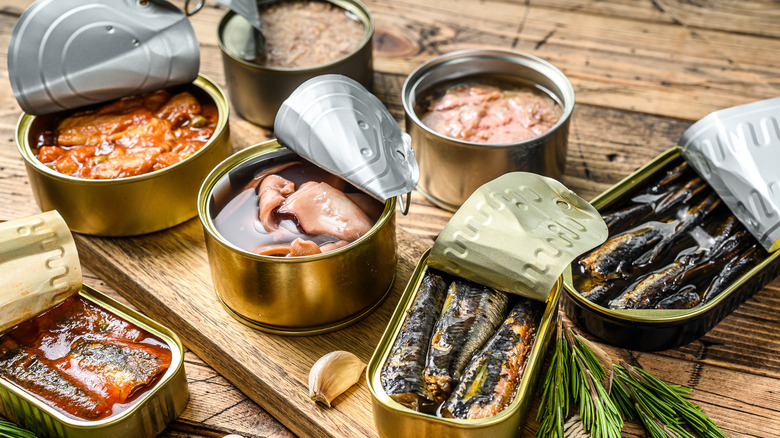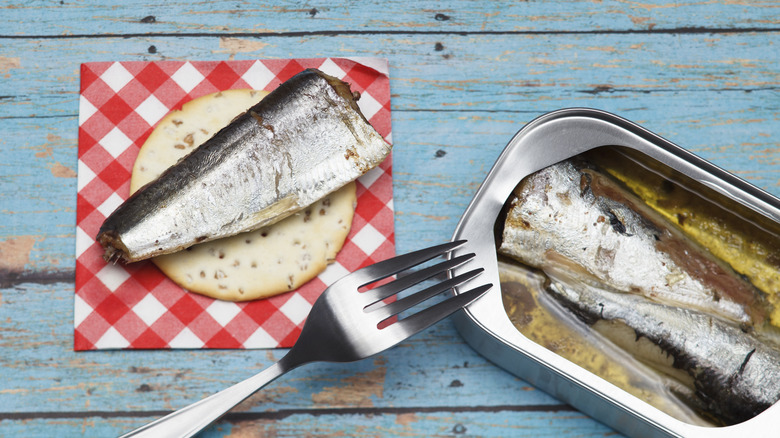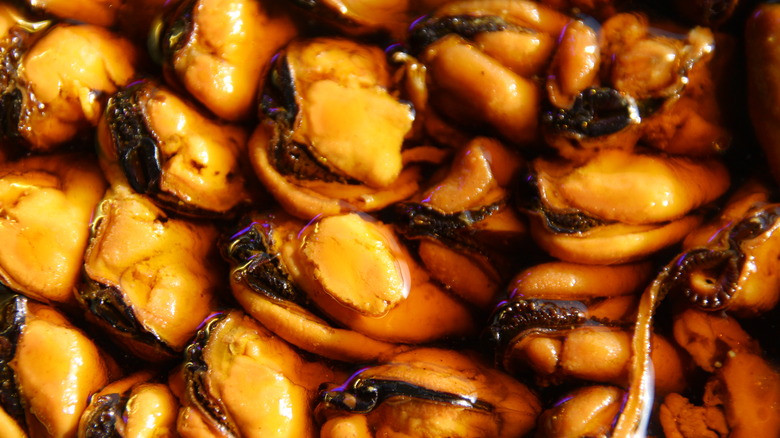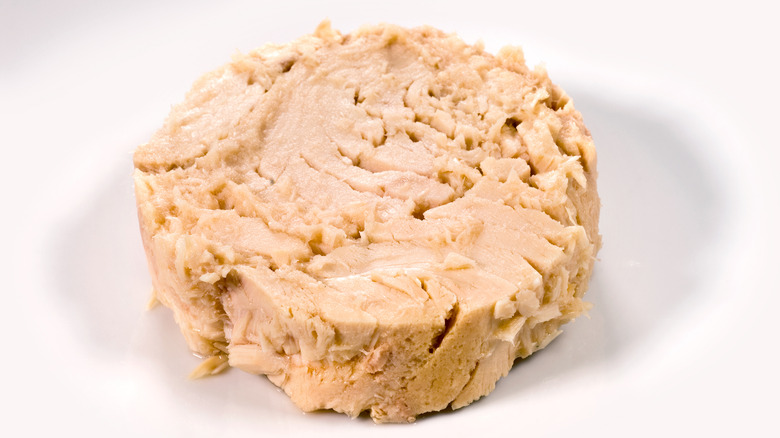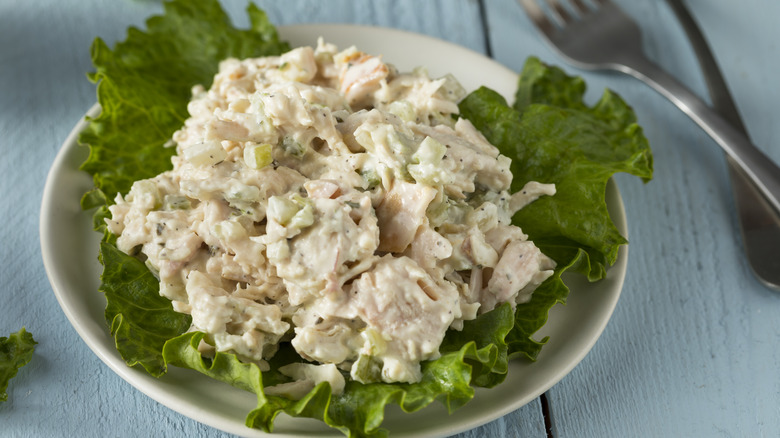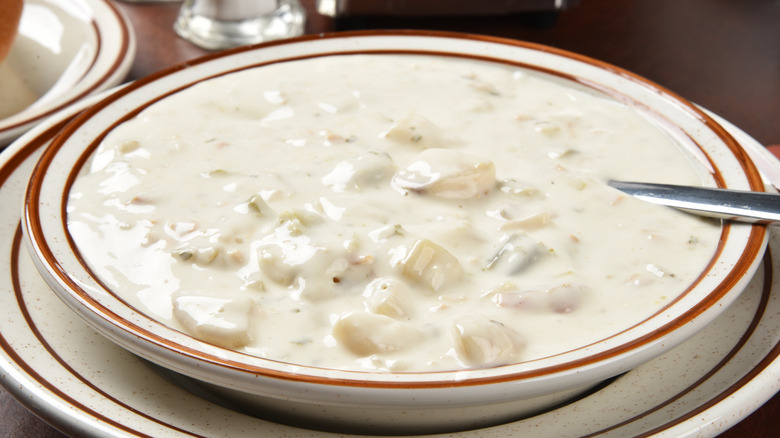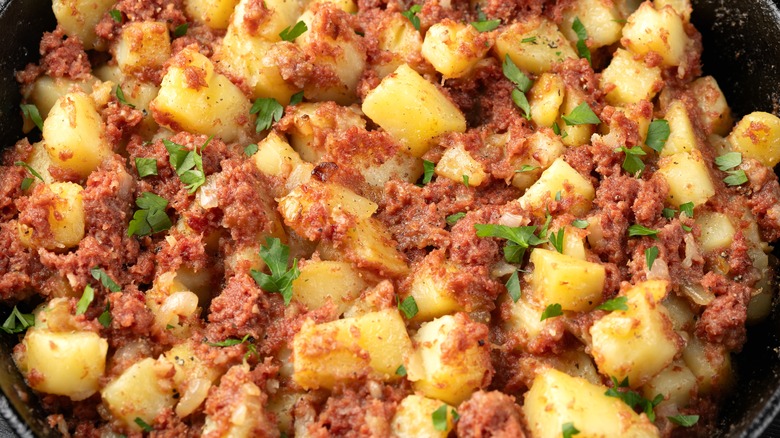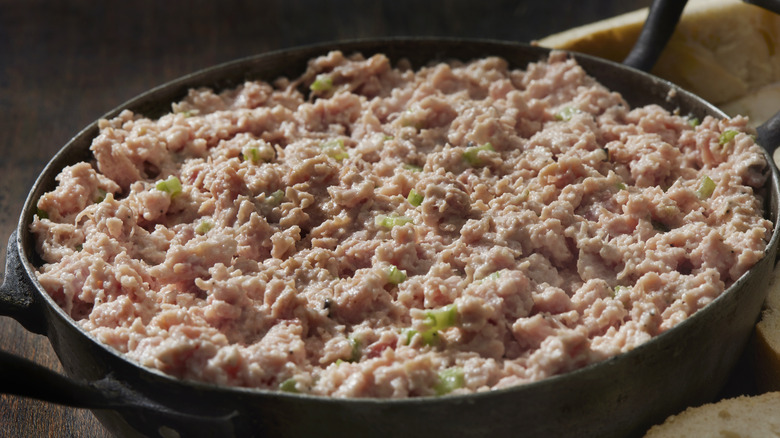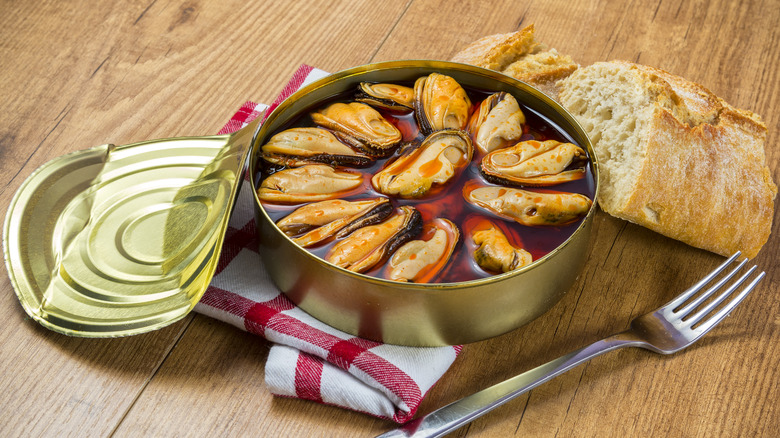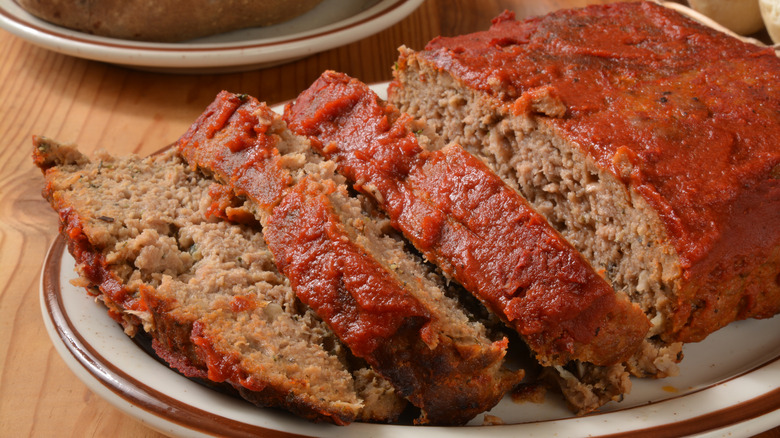14 Canned Meats You Should Have In Your Pantry
With prices on fresh produce and meat consistently on the rise, shoppers on a budget have had to get a bit creative with their shopping lists — which isn't necessarily a bad thing. Fans of grilling steaks and pork chops have seen the charcoal-fueled light of grilling fresh peaches and pineapple and chefs of all experience levels are revisiting the benefits of canned foods. Ever since Nicolas Appert first perfected canned food preservation to fuel Napoleon's military conquests, canned foods have been a household staple for chefs on a budget.
Though canned fruits and vegetables can often be found in the pantries of mainstream shoppers, the wide variety of canned meats often goes untapped. This is a true shame as canned meats bring all kinds of cost benefits to the table while remaining a versatile way to get protein and flavor into a dish. As the process of narrowing down which canned meat should be in your shopping cart can be a bit daunting, here are a few great options to try.
Sardines
The poster-piscis of TikTok's viral tinned fish trend, sardines are an accessible addition to the pantry of any fan of canned tuna. Once a tuna enthusiast experiences the nuanced flavors and silky textures sardines have to offer, there's frankly no going back. From a flavor perspective, sardines provide a smack of umami wherever they are incorporated, plus they have a great nutritional profile with respectable levels of protein and omega-3 fatty acids.
For starters, there's absolutely nothing wrong with eating sardines right out of the can. This is a bit of a short-sell, however, because their true culinary value comes when they are combined with complementary ingredients. To get the most bang for your buck when using sardines, stick with something in the realm of mid-afternoon snack instead of making it a main course. This can be as low-key as scooping a can of sardines into a bowl with some mayo, salt, pepper, and a squeeze of lemon, or as complex as coating them in an herbaceous breadcrumb mix and frying them in oil.
Those wanting to elevate sardines into main course level, however, have plenty of tasty options before them. They make a flavorful addition to salads and have always found a tasty home sprucing up pasta dishes. With a vibrant flavor profile that doesn't overwhelm other ingredients, sardines are a versatile addition to any pantry.
Oysters
There will always be a special place in diners' hearts for the briny delights of freshly shucked oysters with a bit of mignonette, but their canned cousins definitely shouldn't be overlooked. Several brands offer smoked oyster varieties which provide a nice flavor highlight and are tasty enough to eat straight out of the can. Like all the meats on this list, however, canned oysters really shine with a bit of culinary love.
Oysters lend themselves to smaller plates and snacks — smoked oyster dip or oyster chowder come to mind —but this particular mollusk happens to be the star of the Southern po'boy sandwich. While this classic sandwich can be made with anything from chicken to shrimp, the oyster po' boy remains a singular dish — fried oysters simply don't show up in sandwiches that often.
Once you take this regional oyster train further east you'll find that Thanksgiving tables in New England incorporate oysters in their turkey stuffing. According to What's Cooking, America?, using oysters as a stuffing for poultry and chicken dates back to the late 1600s because they were a plentiful source of additional protein and flavor. Fresh, raw oysters are the preference in New England, but there's nothing wrong with including the canned variety in a pinch.
Spam
Arguably the canned meat on this list with the most merchandising, Spam was with the United States as the country struggled through the Great Depression and accompanied its GIs through World War II. Spam's reputation as an economical way to add protein to the table during hard times and its ubiquity on military bases around the world has turned this once-reviled canned meat into a pantry darling.
When it comes to mealtime, Spam is best prepped as something quick for breakfast and lunch. Its porcine flavor pairs nicely with eggs, and the ease of breaking a can of Spam down into cubes lends itself to a quick breakfast casserole. Grilled Spam is a tasty substitute for a ground beef patty — don't knock a Spam-burger until you've tried it–and it's an easy way to spruce up your instant ramen or pasta.
In recent years, the Hawaiian snack known as Spam musubi has captured the attention of American diners–and it's surprisingly easy to make. A bit of vinegary sauce, some roasted nori, plenty of rice, and a few rectangles of grilled Spam are all you need to whip up this delicious Hawaiian treat.
Tuna
While tuna fish may not be the most exciting canned meat on the list, it's cemented its role as a mainstay in pantries worldwide. It's been around for long enough to have a long list of brands and flavors — some better than others — which also means it's been around for long enough to become indispensable.
Canned tuna's claim to fame would have to be tuna salad — the cool, refreshing sandwich star that somehow always tastes better when you make it at home. A good tuna salad typically starts with mayonnaise, but discerning sandwich chefs simply use this as a jumping off point for customization.
It's easy to typecast canned tuna as a cold-only ingredient, but don't forget about the timeless tuna melt or tuna casserole for something hot and melty. When done correctly, a proper tuna melt can work wonders with only a few commonplace ingredients. For something a bit more dinner-appropriate, you can't go wrong with a classic tuna noodle casserole or any noodle dish for that matter. Canned tuna is an excellent way to spruce up your go-to pasta preparation as it provides some added flavor, texture, and protein.
Salmon
Canned salmon can be used interchangeably with canned tuna — it's just right for those who want something on the fancier side. This canned fish classic can be swapped into your favorite tuna salad recipe, crumbled over your favorite greens, or mixed in with your preferred pasta dish.
Also similar to tuna, canned salmon is an ingredient that lends itself to a game day spread. There's absolutely nothing wrong with whipping up some creamy salmon dip with softened cream cheese, sour cream, and a bit of everything bagel seasoning to evoke classic lox and bagel flavor combo.
During the Great Depression, canned salmon joined the ranks of Spam and other canned meats as an economic way to bring some protein to the table. The classic take on salmon croquettes or salmon patties were born from this era of necessity. As canned salmon retains much of its flaky texture, mixing it with some herby bread crumbs and eggs before frying it up in a pan is too good to pass up.
Chicken
Despite its versatility and variety, there are some people who just don't like canned fish. For those who find themselves in this camp but are still looking for ways to round out their pantry, look no further than canned chicken. The chunk chicken is probably the gold standard of canned chicken, but daring shoppers can search for the elusive canned whole chicken if they're really hungry.
Canned chicken offers all the versatility of canned fish, but those who aren't fish fans will appreciate a more muted flavor profile. Like canned tuna, canned chicken is perhaps best known for its presence in chicken salad, best served with plump grapes, crunchy apples, cashews, and a bit of brown sugar. It's tough to beat a buttery croissant that's been sliced in half and piled high with cool chicken salad, but that's not the only area where canned chicken shines. A few cans of chicken sauteed with some cumin and chili powder will create a tasty filling for baked enchiladas, soft tacos, or burritos while also making a flavorful topping for a chef salad.
Clams
Like Hollywood, the U.S. highway system, and Elvis Presley, canned clams came of age in the 1950s. Legend has it that a chip dip made with canned clams debuted on the popular Kraft Music Hall TV Show and America fell in love. It's a simple dish, but that hasn't stopped it from garnering fans like Chef Mike Price of The Clam in New York City over the years. Like most of the dips on this list, the basic foundation of clam dip lends itself to a lot of creative interpretation.
When venturing outside of clam dip territory, you can't go wrong with clam chowder, which is a deceptively easy dish to whip up on a budget. Paired with a creamy stock, freshly chopped aromatics, and some chopped potatoes, canned clams can still be the centerpiece of this New England classic. Of course, there's always room for canned clams in pasta dishes — a few cans of clams sauteed with butter, oregano and onions drizzled onto a tangle of spaghetti is enough to turn a few heads.
Corned beef
In the world of canned meats, corned beef and Spam have been frenemies for decades. Both options are cuboid, salty, and have spent plenty of time getting the side eye from shoppers. However, just like Spam has seen a glow up, shoppers have started to see canned corned beef as something that can add a bit of heft and versatility to your pantry.
Corned beef — so named because of the large "kernels" of rock salt used for curing purposes — is perhaps best known for corned beef hash. The foundation of this easy-to-make classic is simply a can of corned beef, some cubed potatoes, and a chopped onion. While this basic iteration is great for breakfast, lunch, or dinner, it's a blank canvas that is practically screaming for some creative license. Throw some peppers in there for a bit of kick, add some scrambled eggs for a hearty breakfast, or you could even kick it New England style and add some canned oysters to the mix.
Of course, there's no need to make corned beef a monotasker in the kitchen — it's central to many popular dishes like Jamaican bully beef, Puerto Rican carne bif, and Filipino corned beef silog. Just like its frenemy Spam, canned corn beef has had its own culinary journey around the planet, so it's time to lay some respect on its name.
Anchovies
Yes, sardines have already been covered on this list, and yes, there are times when you're going to want to use anchovies instead. While canned anchovies and sardines do share some fundamental similarities, think of anchovies as bringing the big guns to whatever recipe you're making with sardines.
In contrast with sardines, anchovies provide a much more robust umami flavor profile wherever they're used. The fact that it's easier to break them down into a pate-like consistency that concentrates their flavor also sets them apart from their tinned cousins. So what does that mean for the chef?
An umami bomb like anchovies can easily be incorporated into salad dressings or other condiments — think along the lines of eel sauce or oyster sauce. If you're whipping up your own Caesar salad and you're not mixing anchovies into the dressing, you're doing yourself a grave disservice. This disservice counts double when you consider how well that Caesar salad would complement a nice plate of spaghetti with a nice garlic and anchovy sauce or even a homemade pizza topped with a few anchovies of its own.
Deviled ham
Deviled ham differs from its porcine cousin Spam in that it is finely minced to be served as a spread for sandwiches or crackers. Flavor-wise, it shares a lot of similarities with Spam and corned beef — it's salty, smoky and just a little bit sweet. Deviled ham hasn't really kept up with these two canned meat contemporaries, but that doesn't mean it's not worth having in your pantry.
Predominantly manufactured in the United States by Underwood Spreads, deviled ham ran in many of the same circles used by other canned meats because it was an affordable source of protein. Today, deviled ham remains an economical pantry staple that can be used as a combination of canned tuna and Spam or corned beef (as odd as that sounds).
This makes deviled ham ideal for sandwiches or a quick spread for crackers, but it also means there's an ocean of untapped potential inside each of these red devil-bedecked cans. Swapping your corned beef out for deviled ham for a breakfast hash is a tasty option here, as is mixing this into a carbonara-like pasta with a bit of Parmesan and black pepper. It's maybe not the strongest contender on the list, but just don't sleep on this little can when you see it at the grocery store.
Mussels
When discussing canned food and its fresh or raw alternatives, it's easy to overlook the prep factor. Oysters need to be shucked, chicken needs to be sliced or shredded, and ham just doesn't devil itself. Canned mussels are on the list for several reasons, but chief among them is ease of preparation. When you're in a time crunch but you don't want to skimp on flavor, there's absolutely nothing wrong with popping open a can of mussels instead of toiling with a fresh batch to make sure they're grit-free.
That said, canned mussels can be implemented anywhere you need a briny kick. If you've got a variety of canned mussel that tastes a little muted, opt for smoked mussels or any other seasoned variety. From there, they make a great mix in for pastas when sauteed with some butter and herbs or you can even add them to a curry on top of rice for a bit of shellfish richness.
Octopus
Much like canned mussels or other mollusks, canned octopus just needs a little love before it turns into something memorable. When purchasing canned octopus, the mussel rule applies: if it's packed in olive oil or water, chances are you'll get something a bit more muted on the plate. Of course, there's nothing wrong with this —think of it as an opportunity to spruce the protein up on your own before incorporating it into your favorite dishes. If that is a dealbreaker, however, you're likely to find canned octopus that has been smoked or packed in flavor-enhancers like garlic, tomato sauce, or butter.
Once you've prepped it with a bit of butter, garlic, or whatever else tickles your fancy, it's ready to rock and roll. Fried octopus is always going to be a win if you've got an egg wash and some panko bread crumbs handy, but why not just break out the takoyaki pan and host your own tako-pa with your newfound love of canned octopus?
Crab
There isn't much that crab can do wrong in the kitchen, and canned crab is no different. While it's a natural choice for dips, cheese balls, or other small, flavorful snacks, the reason you have crab meat in your pantry is for classic crab cakes.
Before you start mixing up the remoulade, however, it's important to secure the right crab for the job. When shopping for canned crab, your options will typically include lump crab meat or white crab meat. Lump crab meat is the more flavorful and texturally hearty of the two, which makes it the ideal pick for crab cakes.
White crab meat will be your go-to when you're looking to incorporate crab into a refreshing dip, salad, your favorite noodle dish, or prepping a crab melt. Its flakier texture makes it a great stand-in for canned tuna or salmon, and there are few things more pleasurable on a hot summer day than a cold crab salad sandwich. Regardless of which type of canned crab meat you buy, it's always a good idea to inspect each can for errant bits of crab shell — nobody wants that in their crab cake.
Ground beef
Of all the items on this list, canned ground beef may be the biggest game changer. When you think of how commonplace ground beef has become in today's kitchen and pair that with its ever-increasing price tag, it makes sense to try and supplement this demand with a less-expensive alternative.
Meatballs, hamburgers, Bolognese, meatloaf, and many other linchpins of the modern kitchen can be faithfully reproduced using canned ground beef. Like its canned counterparts on this list, there are a wide variety of pre-seasoned options, and it has just as much versatility as the stuff your butcher is selling.
After cooking your way through all those familiar favorites, it's not long before you realize you're still mining the tip of a very large iceberg. With the prep time cut in half, it won't be long before you're adding ground beef to fried rice, scrambled eggs, or even perfecting your own chili recipe. Regardless of your canned meat preference, keeping a few cans of this stuff in your pantry will ensure a versatile cooking experience no matter what's on your menu.
